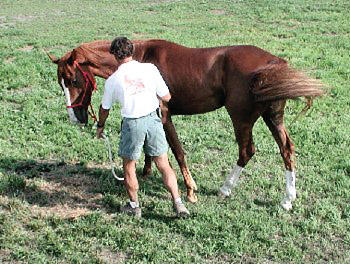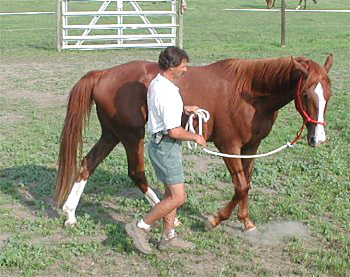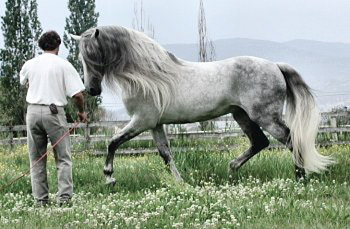Bending and Releasing at the Poll: The Keys to Courage
Paul Dufresne June 2007
Many forms of lunging--or lateral lunging, as some call it--often fall short of increasing a horse’s ability to relax and perform. The purpose of this article is to show how a horse’s state of negative contraction (counter-flexion, inverted) can be changed so that it does not hamper a horse’s ability to improve in its mindset, athletic ability, and more importantly, its emotional well-being. By just modifying our approach a bit, we can accelerate a horse’s ability to accept and feel good about whatever we are asking. A horse, or human being for that matter, that feels relaxed in what we ask is always more positive in its ability to accept new surprises and give a superior performance.
So often, horses are sent on a circle with a lunge line, donut reins and surcingle or saddle, or even a horseman’s halter and line. The horse repeats circle after circle after circle, in many cases with its neck counter-flexed or in an inverted position. When a horse is in this type of position, it increases the resistance in its body, mind, and emotions. Repetition in this scenario actually diminishes any chance of well-being. Even in many cases where Natural Horsemanship is practiced, horses can be sent on remote control around a circle with the handler standing quietly in the center, not realizing that his or her horse is on automatic pilot with this negative type of contraction occurring.
In this scenario, smaller circles may help with the more frequent rein changes (changes in direction), but the longer a horse persists in movements with a tight topline, the more flighty and resistant it will be to learning and accepting any new situation or variable that might arise.
Petting or caressing your horse in this case is ineffective. If a horse is asked to do something that it is feeling "not ok" about, the petting does little to help it overcome that discomfort. Many horses will not habituate and accept--they need more help than that. As soon as your horse starts to show respect
while performing the responsibility you have given it, set up and allow your horse to feel as good as it can about learning with you.

Flash going on a circle, inverted and falling into the circle
In first getting a horse to yield its space at your suggestion in the all the different ways (forward, backward, left, right, up, and down), you can reward it by petting or ending the short lesson and repeating. I would also suggest taking this further by setting the horse up to release at the poll and relax the topline. This is achieved by teaching the horse to lower its head, and by having the horse circle while you use acupressure or pressure on the ribcage to get it to bend properly while moving out in a circle.
Relaxing the Topline
To circle or bend properly, a horse has to relax its topline. This not only releases negative tension, but allows the horse to better use its ring of muscles, effectively increasing athletic ability and decreasing mental, emotional, and physical tension.
Ask the horse to simply lower its head by applying a bit of pressure at the poll with your hand or on a halter, then releasing the pressure when the horse drops its head a bit; this will help relax the topline. Repetition of the pressure release techniques will improve a horse’s ability to lower its head when asked, either when riding in bit or simply doing ground play with a halter or bit. If a horse lowers its head when you ask it at this point, it is much less likely to become emotionally distraught, because the flight reflex has been partially diffused (when there is no tension at the poll and the head dangles from

Flash responding to pressure on the ribcage
and a head down cue on a circle
the neck on plumb, the reflex is wholly diffused). Also, with the horse’s head down, it is less likely to become inverted, as this doesn’t happen when the head is below the withers. This also helps to relax the topline.
Once the horse starts to get an idea of what a head-down cue on the ground is, we then can further progress by asking it to go ahead of us by driving it forward in a circle. As soon as the horse starts to understand going forward on some sort of a circle with you traveling near it, you can begin to slowly tap it with your hand, elbow, or lead line at the ribcage, right where your leg would be if you were riding. If you keep repeating this, the horse will start to shift its weight to the outside shoulder while traveling on a circle. The pressure on the line to the halter or bit will ask it to bring its head down ever so gently.
At first, the horse may need a stronger nudge or a more energetic tap of the lead line to understand moving away from the pressure. The repetition of this movement will cause the horse to progressively relax the topline and put its weight on the outside of the circle. If you keep repeating the pressure to the ribcage correctly, the horse will start to chew and eventually even salivate. This is good. However, some horses will not understand and may resist at first because they have already been taught to develop a state of negative contraction by moving in circles counterflexed or inverted--or the horse might resist just because you are asking for something new. If you keep applying pressure to the ribcage more vigorously, the horse will start to move its ribcage away from the contact. With repetition, the horse will start to respond to lighter pressure. By setting up the horse this way, it can not help but relax the topline, which relaxes the emotional, mental, and physical state of the horse.
Repeating this over and over allows the horse to reward itself by increasing its state of well-being. The horse then can easily be asked to do a leg yield or shoulder-in from the ground, which can then be transferred to the saddle. This doesn’t just create a more balanced and flexible horse--it brings the horse to that feel-good zone, which is a reward for the horse and for you. Once in this zone, anything you ask of the horse will be received with more compliance and lightness.
The Key to Courage
Now, coming back to Training for Courage, how does this improve a horse’s courageous ability? Quite simply, a horse that learns to feel good with you, as well as feeling better about itself, is much more adaptable and calm in any new situation. This is especially true when you can keep bringing it back to where it feels good, even if it is initially worried and flighty. By making sure you develop very strong relaxation cues that become both reflexive and necessary for the horse to do proper circles or bending, you can always help bring it back to that feel-good zone.

Flash responding and learning to bend on the circle with pressure on the ribcage
Horses are not that different from us: when we feel good we have little place be fearful, too! At clinics, I find that the more the horses are set up to feel good, the more courageous the owners also become because the horses are compliant, calm, and happy. If the handler and the horse feel good, it takes something pretty drastic to turn the situation caustic. This, coupled with sensible and creative advance-retreat techniques, will prepare any horse and owner to accept the scariest situations. Don’t take my word for it--prove it to yourself and your horse. Imagine yourself riding a relaxed horse whose confidence is unshakeable...this could be you!
Other techniques I have found that compliment and aid in facilitating this state of well-being are endo-tapping and twirling.
Endo-tapping (JP Giacomini & Allen Pogue) is a rhythmic tapping near the withers/ribcage area with a whip that has a bouncy ball at the end. This will also help the horse relax its topline and develop strong relaxation cues. This works on horses of all ages.
Twirling further enables a horse to relax by making it easier for the horse to release the poll. Dr. Deb Bennett wrote a great article on this several years back. Twirling (also called jaw flexions) is an exercise that enables a horse to achieve a relaxed state with the least amount of resistance. This exercise not only asks the horse to lower its head with a bit of downward pressure at the poll, but further has a tinkle of pressure on one side of the halter or bit. This facilitates the release at the poll so the horse's C-1 vertebra is not wedged in a locked position and can actually drop out of the locked position when there is no muscular tension in the topline. When this is coupled with rib pressure on a circle, it is very effective. I like to tinkle the lead on a bit while practicing a good bend on the circle, and then release it when the horse lowers its head and releases the poll ever so slightly

Quimerico showing what self-carriage at liberty
should look like